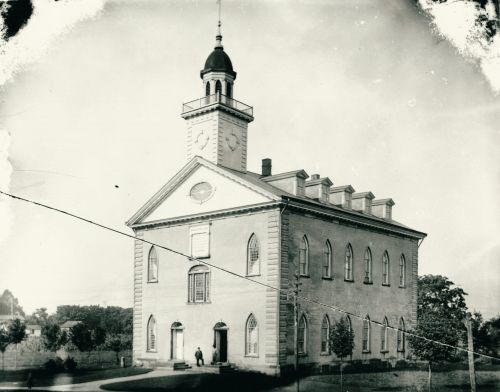I’ve been a fan of the Joseph Smith Papers Podcasts since the release of The First Vision podcast in 2020, and the latest in the series, Kirtland, City of Revelation is no exception. Perhaps my interest lies in the fact that Kirtland is a period in the Church’s history that I have never known a ton about, but I also appreciate host Spencer McBride’s approach to history and the way he frames the podcast even as early on as the show’s trailer.
“As a historian immersed in the records that Joseph Smith and others left behind, there is one theme from the history of Kirtland that stands out to me above all others,” McBride says. “While people flocked to Kirtland to receive the word of God through the prophet Joseph Smith, Joseph Smith was intent on teaching people how to hear the voice of God themselves. At its heart, the story of Kirtland, Ohio, in the 1830s is a story about men and women seeking to hear the voice of God in their lives.”
Yes, the podcast includes many of the stories we’ve heard before including the construction of the Kirtland Temple and the Kirtland Safety Society. But I was particularly struck by the faith of two couples whose names I was familiar with but whose contributions to the early church I have never fully appreciated.
Sidney and Phebe Rigdon
Sidney Rigdon had every reason to pass on accepting the gospel of Jesus Christ. As a trained minister who had become associated with a movement to restore early Christianity, He was a man of significant influence in Kirtland and surrounding areas. But upon being introduced to the gospel by Parley P. Pratt and Oliver Cowdery, he faced a decision: Would he give up his livelihood to join the Saints?
“He broached the subject with his wife, Phebe. As it’s recorded in Joseph Smith’s history, Sidney asked Phebe, ‘My dear, you have once followed me into poverty. Are you willing to do the same?’” the podcast recounts. “Phebe responded, ‘I have counted the cost. It is my desire to do the will of God, come life or come death.’ Soon thereafter, Sidney and Phebe Rigdon were baptized.”
► You may also like: The miraculous conversion stories of 4 preachers who gave up everything to join the Church
Rigdgon’s preaching proves to be a huge asset to the growing church as he had a great ability to capture listeners’ attention and draw them in.
“Oftentimes in those early years when Joseph needs someone to preach publicly, it is a prominent Fourth of July sermon, he’s going to turn to Sidney Rigdon because Sidney is just an amazing preacher. And people lived in an oral culture back then more than we live in an oral culture. I mean if there’s a sacrament meeting talk and it’s gone past twelve minutes, our minds are wandering and we’re fidgeting in our seats. We just live in a different culture.
“People could listen to Sidney Rigdon preach for an hour, for an hour and a half. This is what they did. … And so very quickly, he’s going to become so instrumental to Joseph Smith and really a tutor, a mentor to Joseph Smith. If you think about it, Joseph Smith has never led anything. Sidney Rigdon has. Sidney is organized. He’s led congregations. He knows how to work with people in a way that Joseph in his mid-twenties just doesn’t understand yet.”
Sidney was nearly 13 years older than the Prophet Joseph and became not only a trusted friend but one with whom Joseph shared incredibly sacred experiences. In fact, Sidney was with Joseph on February 16, 1832, when the two received what became known as “The Vision,” a vision of what happens to men and women after they pass from this life to the next. The two men wrote of the experience, “We beheld the glory of the Son, the right hand of the Father, and received of his fulness.”
It was this vision that also led them to proclaim, “and now after the many testimonies which have been given of him this is the testimony last of all which we give of Him that He lives.”
The vision served as a catalyst for greater persecution from critics of the Church who viewed it as a threat to long-held Protestant beliefs about the afterlife. Thus, on March 24, 1832, Joseph and Sidney were brutally attacked.
“The mob pulled Sidney Rigdon from his home and dragged him by his feet to the base of a large oak tree,” McBride explains on the podcast. “The way the mob dragged Rigdon caused his head to bump repeatedly against the hard ground and he was soon unconscious.” It was the night that Joseph was tarred and feathered, a brutal act intended to humiliate while causing tremendous pain. According to Mark Staker, a curator with the Historic Sites division of the Church, Sidney Rigdon “never quite recovers” from this attack.
While we know that Sidney eventually ends up falling away from the Church, it is undeniable the influence he had on the early church and its success during the Kirtland era.
Newel K. and Elizabeth Ann Whitney
Most of us have heard the story of Joseph Smith’s first encounter with Newel K. Whitney when he pulled up in front of the Whitneys’ store, jumped from a sleigh, and proclaimed, “Newel K. Whitney, thou art the man. You have prayed me here, now, what do you want of me?” But did you know that the Whitneys had actually come in contact with the Church previously? I didn’t.
Apparently, the Whitneys were members of Sidney Rigdon’s congregation and had a particular interest in religion. Specifically, they wanted to better understand the gifts of the Spirit spoken of in the New Testament and prayed frequently to be recipients of these gifts.
“As Elizabeth recalled years later, one night while praying she and her husband saw a vision. In that vision, they saw a cloud resting over their house and a voice from heaven declaring, ‘Prepare to receive the word of the Lord, for it is coming,’” the podcast explains. “Not many days later the first Latter-day Saint missionaries arrived in Kirtland and Elizabeth believed what they preached.” Newel was not initially as receptive but eventually began participating with the Church as well.
“But after the missionaries left Kirtland, this large group of new converts were disorganized and often debated among themselves on matters of doctrine and modes of worship. So Elizabeth and Newel Whitney continued to pray for divine direction,” McBride says. Thus, their prayers were the prayers Joseph spoke of when he jumped from the sleigh in February 1831.
Whitney didn’t recognize Joseph and asks for clarification. Joseph explains that he saw Newel in a dream praying for him. Newel and his family quickly become fully converted to the gospel. The Whitneys not only invited Joseph and Emma to live with them until they could be more settled in the area of Kirtland, but they even gave us their bedroom as Emma was pregnant with twins at the time of their arrival.
Newel and Elizabeth Ann had a great desire to care for the poor in their community and in a later episode, Jenny Reeder, a historian in the Church History Department, shares how they created what they called a three-day “Feast for the Poor” in January 1836.
The Feast for the Poor was an idea borrowed from the Methodists—the Whitneys gathered items that they had collected as store owners as well as donations from other Saints who were able to contribute, and they invited the poor to come and eat.
“Not only eat physical food,” Reeder explains. “But he also invited Joseph Smith to come and to feed them spiritually. … I love this because I think this is just the beginning of relationships and friendships and caring for the poor that extends out into Nauvoo. When Newel K. Whitney and Elizabeth Ann Whitney came to Nauvoo, they had nothing. They were poor and, of course, who took them in? Emma Smith and Joseph Smith.”
► You may also like: ‘It was my ladies’: How a Church historian undergoing chemo found comfort in the lives of early Latter-day Saint women
Newel and Elizabeth Ann remained faithful for the rest of their lives.
As Elder Kyle S. McKay, General Authority Seventy and Church Recorder puts it at the conclusion of the podcast, “Kirtland was a place of abundant revelation, but I think it’s important for our members to remember that the abundant revelation continues. Revelation in context for the purpose of the restoration just flowed in Kirtland. But in personal lives, it didn’t stop there and it continues now.”
And I guess that’s the thing that struck me as I learned more about the stories of these men and women. God spoke, not only to His Prophet, but also to those who sought Him and wanted to follow Him. He used their faith and their unique talents and abilities to build up the kingdom of God on the earth. And if He did so then, certainly He continues to do so now.


